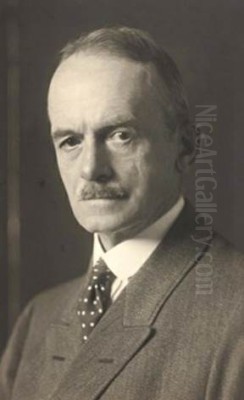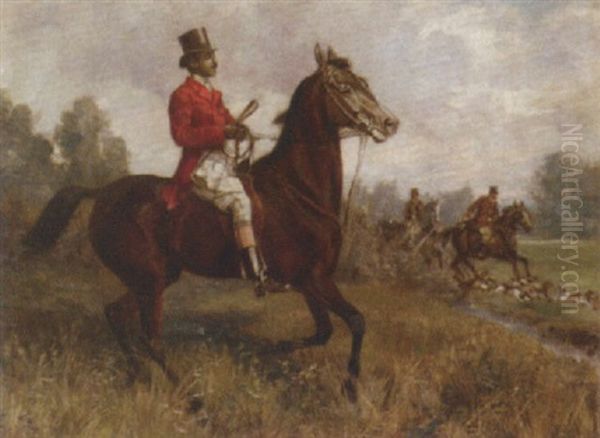
Angelo Jank stands as a significant figure in the landscape of German art at the turn of the 20th century. Born in Munich in 1868 and passing away in the same city in 1940, his career spanned a period of intense artistic transformation. He is recognized not only for his own distinctive contributions as a painter and printmaker but also as a pivotal pioneer of German modernism, a co-founder of the influential Munich Secession movement, and a respected professor who shaped a generation of artists. His work, often characterized by dynamic compositions and a vibrant palette, captured the spirit of his time while leaving a lasting legacy, despite the tragic loss of some major works to historical events.
Early Life and Artistic Formation
Angelo Jank was immersed in the world of art from birth. His father was Christian Jank, himself a notable painter, particularly known for his theatrical and architectural designs, including significant contributions to the fantastical castles commissioned by King Ludwig II of Bavaria. Growing up in Munich, a major European art center, provided young Angelo with a rich environment for artistic development.
He pursued formal training at the prestigious Munich Academy of Fine Arts (München Akademie), the city's leading art institution. During his studies, he likely benefited from the instruction and influence of prominent academic painters of the era. Sources suggest potential mentors or influences included figures like Ludwig Loefftz and Paul Höcker, who were associated with the Academy and represented different facets of late 19th-century Munich painting, moving from realism towards more modern sensibilities. This academic grounding provided Jank with the technical skills upon which he would build his more progressive artistic vision.
Co-Founding the Munich Secession
The late 19th century saw a growing dissatisfaction among younger, more forward-thinking artists with the conservative attitudes and exhibition policies of the established art institutions. This led to the formation of "Secession" movements in various European cities, aiming to break away (or "secede") from the official salons and create independent platforms for modern art.

Angelo Jank was at the forefront of this movement in Munich. Alongside other progressive artists, most notably the highly influential Franz von Stuck, Jank played a crucial role in founding the Munich Secession (Münchener Secession) in 1892. This was one of the earliest Secession movements and set a precedent for similar groups in Vienna and Berlin. The Munich Secession sought to promote artistic freedom, embrace international trends like Impressionism, Symbolism, and Art Nouveau (known in Germany as Jugendstil), and provide exhibition opportunities outside the control of the traditional Künstlergenossenschaft (Artists' Association). Jank's involvement underscores his early commitment to modernism and artistic innovation.
Artistic Style, Themes, and Techniques
Angelo Jank's artistic output is often associated with the Munich Secession and the broader Jugendstil movement. His style is characterized by energy, dynamism, and often a decorative flair. He was particularly renowned for his depictions of horses and equestrian scenes – capturing the power, movement, and elegance of these animals in hunting scenes, races, or military settings. His brushwork could be vigorous and expressive, contributing to the sense of motion in his compositions.
While adept at oil painting, Jank also embraced other media. He was a skilled graphic artist and printmaker. His work in poster design was notable, contributing to the flourishing field of applied arts associated with Jugendstil. A specific example mentioned is the poster La femme au perroquet (The Woman with the Parrot) from 1898, likely showcasing the decorative lines and stylized forms typical of the era.
Furthermore, Jank explored printmaking techniques, including color lithography, which was considered an important artistic form at the time. His engagement with lithography, as well as evidence suggesting work in woodcut and linocut, demonstrates his versatility and interest in the diverse possibilities of visual expression promoted by the modern art movements. His subject matter also extended to historical paintings, although tragically, some of his most significant works in this genre were lost.
A Distinguished Teaching Career
Beyond his own artistic practice, Angelo Jank made a profound impact through his role as an educator. He became a professor at the Munich Academy of Fine Arts, the very institution where he had trained. This position allowed him to influence and mentor a significant number of aspiring artists over several decades.
His reputation as a teacher attracted students who would go on to achieve recognition in their own right. Among his most notable pupils were the British-born avant-garde poet and artist Mina Loy, the American painter Frank Figge (whose name sometimes appears as Figyes or Figueras in sources), and Ernest Hennings, who later became a prominent member of the Taos Society of Artists in New Mexico, known for his depictions of Native American life and Southwestern landscapes.
Other students who benefited from Jank's tutelage included Wilhelm Nikolaus Prachensky, who became a key figure in developing a distinct form of Tyrolean modernism, Siegfried Adolph, who absorbed influences from Expressionism, and Roman Feldmeier, noted for his work as a war artist. Jank also taught painting classes at the Munich Künstlerinnenverein (Association of Women Artists), where he worked alongside contemporaries like Max Feldbauer and Theodor Hummel, further extending his educational reach. His role as an educator cemented his influence on the trajectory of early 20th-century art, particularly within the Munich scene.
Exhibitions and Recognition
Throughout his career, Angelo Jank actively participated in the art world through exhibitions. As a co-founder and member of the Munich Secession, he regularly showed his work in their influential exhibitions, often held in dedicated pavilions or within larger showcases like the annual exhibitions at the Munich Glaspalast (Glass Palace). The Glaspalast exhibitions were major events, and Jank's presence there, including within the Secession's section, highlighted his standing in the contemporary art scene.
He also exhibited frequently at the Grosse Münchener Kunstausstellung (Great Munich Art Exhibition), another significant annual event presenting a broad spectrum of German art. His participation extended over many years, with records indicating involvement in shows at the Munich Kunsthalle as late as 1931 and 1939. His historical paintings, before their destruction, were among the works displayed at the Glaspalast. Furthermore, his involvement with the Künstlerinnenverein suggests participation in their exhibitions as well.
Beyond exhibitions, evidence of his graphic work exists in the form of a published sketchbook dating from 1890. This book, containing figure studies and nudes in charcoal, pencil, and red chalk, offers a glimpse into his working process and foundational drawing skills. His name and influence also appear in publications discussing the lives and training of his students, such as Mina Loy.
Contemporaries and Artistic Milieu
Angelo Jank operated within a vibrant and complex artistic environment in Munich. His most significant collaborative relationship was arguably with Franz von Stuck in the founding of the Secession. While working towards a common goal, their individual artistic styles differed, with Stuck often leaning towards Symbolism and mythological themes.
His contemporaries within the broader Munich art scene included fellow painters associated with Jugendstil and the Secession, such as Walter Georgi, Walter Püttner, and Leo Putz. These artists, while sharing some common ground, each developed their own distinct approaches.
His teaching role placed him in contact, and potentially in a form of professional competition or comparison, with colleagues at the Academy and the Künstlerinnenverein, such as Max Feldbauer and Theodor Hummel. His relationship with his students was primarily pedagogical, though the success of pupils like Mina Loy (who later associated with international figures like Augustus John) and Ernest Hennings demonstrates the effectiveness of his teaching, even as they forged their own paths, sometimes diverging significantly from Jank's own style. His connection to his father, Christian Jank, represents an intergenerational link within Munich's artistic lineage.
The Tragedy of the Reichstag Fire
A significant and tragic event impacting Angelo Jank's legacy was the Reichstag fire in Berlin on February 27, 1933. While the fire had profound political consequences, marking a pivotal moment in the Nazi consolidation of power, it also resulted in devastating cultural losses. Among the artworks destroyed in the blaze were three large-scale historical paintings by Angelo Jank that were housed in the Reichstag building.
The specific subjects of these lost paintings are not always detailed in readily available sources, but their destruction represents an irreplaceable loss to Jank's oeuvre. Historical painting was a prestigious genre, and these large works likely represented significant artistic statements by Jank. Their loss makes a full assessment of his range and ambition more difficult for contemporary art historians and audiences. This event underscores the vulnerability of cultural heritage to political turmoil and disaster.
Legacy and Art Historical Significance
Angelo Jank's position in art history is multifaceted. He is firmly established as a key figure in the Munich art scene around 1900, particularly as a driving force behind the Munich Secession. This role places him among the essential pioneers who challenged academic conservatism and paved the way for modern art in Germany. His embrace of Jugendstil aesthetics, particularly his dynamic compositions and focus on movement, contributed significantly to the visual culture of the era.
His specialization in equestrian and hunting scenes carved out a distinct niche, showcasing his skill in capturing animal anatomy and energetic action. While perhaps less radical than some of the Expressionists who followed, Jank's work represents an important transition, blending academic skill with modern sensibilities in color and composition.
His most enduring legacy, however, might be his influence as a teacher. By mentoring artists like Mina Loy, Ernest Hennings, and Wilhelm Nikolaus Prachensky, he contributed to the development of diverse artistic voices that extended far beyond Munich, reaching into international avant-garde circles, American regionalism, and Austrian modernism.
The loss of his major historical paintings in the Reichstag fire undoubtedly affects his visibility and the scope of his recognized work today. Nevertheless, through his surviving paintings, prints, posters, and the documented impact of his teaching, Angelo Jank remains an important artist for understanding the development of modernism in Munich and Germany. He represents a vital link between 19th-century traditions and the artistic innovations of the early 20th century.
Conclusion
Angelo Jank was more than just a painter of spirited horses and elegant scenes. He was an active participant and shaper of his artistic times, a co-founder of a seminal modernist movement, a dedicated and influential educator, and a versatile artist working across multiple media. His contributions to the Munich Secession helped redefine the city's art landscape, while his teaching nurtured talents that would make their mark internationally. Though shadowed by the loss of significant works, Angelo Jank's career reflects the dynamism and transformations of German art at a crucial historical juncture, securing his place as a noteworthy figure in the narrative of European modernism.